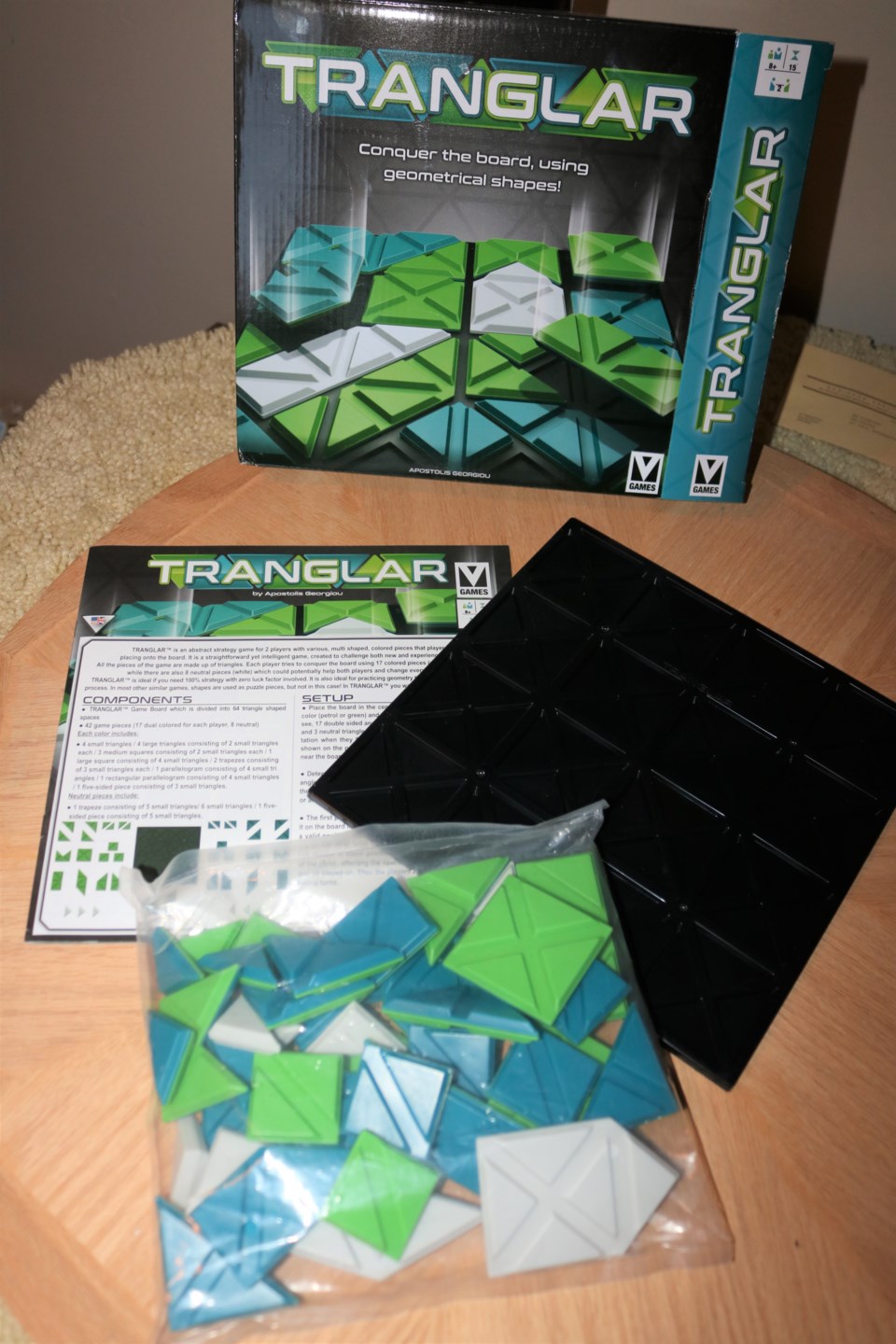A new game to challenge players to gain the largest area of the game board as possible in order to win is Tranglar from designer Apostolis Georgiou.
Tranglar, from V Games, is a two-player offering with each player having access to a pool of multi shaped, colored pieces that players are trying to play onto the board.
It is pretty straightforward in the placement mechanic, the board well-defined in terms of fitting the various-sized pieces each player has.
Each piece is made up of triangles and has a different colour on each side, (think Othello-like), one for each player, while neutral pieces have the same colour on both sides.
The two colours come into play, because, like in Othello, when certain condition are met, you may flip an opponent’s pieces to your colour.
For the designer, Tranglar is a first.
“I began, in my teens, making simple games to play with friends,” explained Georgiou via email.
“My first one was a dexterity football table game, like Subbuteo. Later the game advanced to higher standards but the requirement to play it in large tables had always been a disadvantage.
“This was followed by two theme games, Pelloponesian war and Battle of Crete. The first was a game of luck and the second proved to be - too heavy - for my standards.
“Two more dexterity games were followed by another Strategy board game but all of them remained prototypes played only by friends with no commercial presence.
“All those adventures though, made me wiser. I realized that I wanted to focus in easy, smart, open, quick games. Under those circumstances, Tranglar was the result of my first abstract concept ever.”
Interestingly Georgiou wouldn’t be described as an avid abstract strategy fan.
“Although in my youth, I played chess and checkers, I have never been an abstract strategy fan,” he said. “I always preferred dexterity games and I disliked ‘’heavy’’ board games with fantasy stories, lots of figures, cards and dice.”
But, Tranglar is most certainly an abstract strategy game, one with elements that can turn a game from near loss to almost assured victory in a single move that starts a chain-reaction dramatically altering the board.
“Experience made me believe that after so many successful games in the market, there is no chance for a game to succeed unless it is based on an innovative concept,” offered Georgiou. “Even more, games based on ‘inverse thinking’ could have a greater chance of success. That was exactly the idea behind Tranglar’s process of development. The concept began from a simple jigsaw puzzle and then I found that roles, methods, figures, gameplay had to be reversed. The thought – ‘what if instead of teamwork we had a constant friction and before any move we had to foresee a trap from a bright opponent’- had been the beginning. Based on this controversial approach, puzzle pieces do not cooperate but confront each other. Τhis results in an unusual war of geometrical shapes where tactical and strategic methods are competing with smart decisions and quick board orientation.”
That sounds far deeper than the actual rule set turned out, but it was a process for the designer to work through.
“Game design has to deal with many different parameters,” said Georgiou. “It is the responsibility of the designer to prioritize them. Number and age of players, comprehensible rules, game duration, easiness to play it, continuous surprises that may change result any minute, extendable gameplay so as to interest novices and experienced players alike, seemed to be the most important.
“As small changes in any of them affected more or less most of the others, their optimization required extensive playtime period and numerous game tests. The combination of those parameters has indeed been the greater challenge.”
But, Georgiou is happy with the result of his efforts.
“Tranglar has two advantages,” he said. “The first has to do with its innovation. Geometrical shapes, continuous surprises and game methodology make it unique.
“The second and most important aspect of the game is its ability to appeal to all ages. Children love it as an educational tool. By utilizing triangles, squares, rectangles etc. they learn space orientation and how to complete a board with simple geometrical shapes.
“On the other hand, by testing their problem solving skills and spatial reasoning, grown-ups find it easy going and entertaining.
“It is game they ask to play again and again.”




